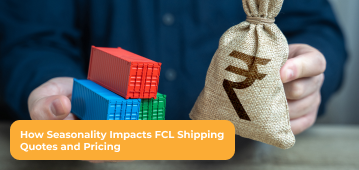Ocean Freight Rates: A Guide to Understanding
A business’s reputation depends on its ability to transport products and meet customer demands in strict deadlines. A well-connected supply chain network with economical transportation helps a business meet customer demands. Ocean freight is among the most popular cargo transportation methods used by businesses worldwide. Understanding how Ocean Freight Rates fluctuates can allow businesses to benefit efficiently.
What drives the demand of ocean freight services?
Businesses are finding new markets and customer bases regularly. This is often not restricted by location. As a result, businesses need to transport their products internationally to cater to this growing demand. This requires efficient, swift, and reliable transport of cargo. Furthermore, transportation must be economical to ensure businesses do not lose money when trying to cater to this new customer base. Ocean freight services meet this need. Technological advancements in ocean freight have increased the popularity of the service.
Any business that aims to transport cargo using ocean freight should first understand the ocean freight rates. Understanding the specifics behind the calculation of these rates allows the business to determine its profit margin and expenses.
Determinants of ocean freight rates
- Delivery rates: The shipment cost is the first cost added to the cargo. This cost includes transport from the pick-up location, packaging of the cargo according to company guidelines, transport of cargo to the port, port charges and formalities, creation of bills of lading, and transport to the delivery location. These are some standard costs charged by all services.
- Port charges: Port charges such as tariffs are non-negotiable. Ports all over the country levy charges for cargo handling. The freight company pays these tariffs in full and then divides accordingly into all shipments. The cost incurred by the business depends upon the size and weight of the shipment. Additional charges are also included if the business has requested special handling or other extra services.
- Customs and duties: Customs and duties are another non-negotiable part of ocean freight. This is usually charged for international shipments. The cost of customs and duties varies from country to country. The port officially publishes the charges at regular intervals – for example, per year or per quarter. This can be found online by visiting the port’s website directly.
- Insurance costs: Insurance is required by all ocean freight services. While many businesses try to get out of paying insurance, they often do not understand its advantages. Insurance ensures the business does not suffer loss if the cargo is damaged or lost during transport. This is especially advantageous if the cargo is high-value or in large quantities. Insurance costs depend on the size and type of cargo and delivery location.
- Freight rate: The freight rate depends on the size and volume of shipment, the chosen container, and the type of container chosen. For example, businesses can opt for less than container load (LCL) or full container load (FCL).
The freight rate also includes some other factors such as basic sea freight charges, documentation fees, inland haulage (if applicable), bunker adjustment factor, terminal handling charges, and currency adjustment factor. It is important to see whether it includes all of these factors or is charged separately when checking the freight rate.
What happens next?
The process of ocean freight starts with drawing up a shipping contract. The contract includes all the five charges listed above and the total sum that the business is expected to pay. The contract also includes international commercial terms, which are internationally recognized responsibilities that buyers, sellers, and freight services must abide by. Some common options that are included are as follows:
- Free onboard: Under this method, the shipment responsibility is divided into those of the seller and the buyer. For example, the seller is responsible for packaging and loading the goods while the pick-up responsibility remains with the buyer.
- Ex-works: Under this method, the entire responsibility remains with the buyer. They are responsible for transporting goods from the pick-up location to the drop-off location.
- Shipment duty paid: In this method, a majority of the responsibilities lie with the seller. For example, the seller is responsible for shipping, insurance, inland transportation, etc. At the same time, the buyer holds minimal to no responsibility.
The final costs
As the five segments above have demonstrated, most of the shipment cost depends on the cargo’s size, quantity, and type. For example, delicate and high-value cargo such as glass products likely needs higher insurance, resulting in the shipment cost increasing.
The final ocean freight cost includes all of the five charges explained above. Therefore, the business should include both profit margin and shipping cost into their international shipping charges when accepting orders from customers. In the case of a large consignment, the overall cost of ocean freight can be divided by the number of units, and a small discount can be given to the customer.
Like





Comments